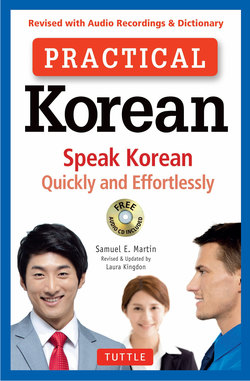Читать книгу Practical Korean - Samuel E. Martin - Страница 21
На сайте Литреса книга снята с продажи.
ОглавлениеLESSON 14
Some Tricky Particles
The 2-shape particle euro/ro has the shape ro after vowels, and euro after all consonants except l; after l the shape is lo: gi ch’aro, bareun pyeoneureo, oen pyeoneureo.
The meanings of the particle are as follows:
| (1) Manner as | Hoewoneu-ro gaiphaeseoyo. 회원으로 가입했어요. |
| I signed in as a member. | |
| (2) Function as | Hanguk-e haksaeng-euro wasseoyo. 한국에 학생으로 왔어요. |
| I come to Korea as a student. | |
| (3) State is; and | Jeo sonyeoneun Gim seonsaengui ttal-lo Busaneseo salgo iseoyo. |
| 저 소녀는 김 선생의 딸로 부산에서 살고 있어요. | |
| That girl is Mr. Kim’s daughter and is living in Pusan. | |
| (4) Direction toward; to | Oenjjok-euro gaseyo. 왼쪽으로 가세요 |
| Go to the left. | |
| (5) Means with, by | Na-neun yeonpil-lo pyeonji-reul sseoyo. 나는 연필로 편지를 써요. |
| I’m writing this letter with a pencil. | |
| Bihaenggi-ro wasseoyo? | |
| 비행기로 왔어요? | |
| Did you come by plane? |
The 2-shape particle eun/neun has the shape eun after consonants, neun after vowels. For example: jip-eun, hakgyo-neun. The tricky thing about this particle is its meaning and use. As a tag translation you can try as for: as a tag meaning you can think of it as the TOPIC indicator.
